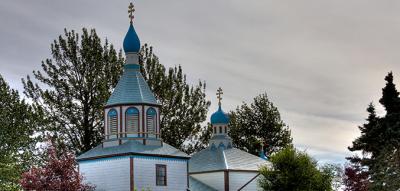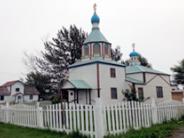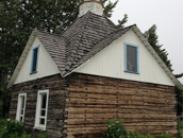Old Town
Consider a walking tour of Old Town Kenai. You can get a map at the Kenai Chamber of Commerce and Visitors’ Center to locate some of these highlights.
Moosemeat John’s Cabin – at the corner of Main Street and Overland – Given the name of “Moosemeat John” for hunting moose to feed his thirteen children, John Hedberg homesteaded with his family in Nikiski, often sharing the success of his efforts.
Fort Kenay - Originally constructed in 1869 by the U.S. Army, Fort Kenay was a series of barracks where more than 100 soldiers were stationed. These soldiers were the men of the F battery 2nd Artillery. Some of the soldiers stationed here in Kenai were veterans of the American Civil War. After 17 months the fort was abandoned and the soldiers were sent back to states such as Idaho and Oregon to assist in the quelling of an Indian uprising. Today visitors can see a replica of the fort that was reconstructed as part of the Alaska Centennial in 1967. It began as a museum and community hall symbolizing transition from Russian to American ownership. Fort Kenay is a replica of the original Russian Orthodox Church school built in 1900, which taught classes in catechism, Russian language, Church Slavonic, arithmetic, and music.
- Historic Kenai Cabins and 75 mm Howitzer. These cabins were recently relocated to city-owned land on Main Street in Old Town Kenai.
- The Arness Cabin was built in 1925 by Emil Berg, a well known registered guide and trapper on the bluff east of Riverview Road in Kenai. The hand hewn corners and joinery reflect a form of construction carried over from his home country of Finland. In 1948, Peggy and James Arness bought it to use as their home. They modified and added on to the original structure, and at one time the cabin was used as Kenai’s first kindergarten.
- The Miller Cabin. Pioneer Emil Ness built this structure in Kasilof in 1910. In 1930, its logs were numbered and it was disassembled and barged to Kenai, where it was pieced back together again. In 1937, the family of Emil’s brother, Gust Ness, sold the cabin to Ward Showalter, who sold it to Kenaitze Chief George Miller in the 1940s. The cabin was donated to the city in 1975.
- The Dolchok/Juliussen Cabin. This cabin was built in Kenai in 1922 by Mike Dolchok. He sold it in the late 1940s to Julius Juliussen, who moved it near the present site of the Peninsula Oilers ballpark and lived in it with his family for many years.
- The Three Scandinavians Cabin. This cabin may have been built in the 1920s, but no one is certain.
- The 75 mm howitzer. The date stamped on the combat cannon is 1917. It was given to the city of Kenai by the Wildwood military base.
Kenai Commercial Company - Now Ken Cole Attorney at Law Office. This was the main store on the Kenai for many years. It was built in 1948 and was originally located in Kasilof. It was barged by E. Wells Ervin and Helen Jones to sell groceries and dry goods. Their slogan – “buy on credit, pay after fishing”.
(1946) Kenai Bible Church – This church was the first Protestant church in Kenai. It also borders the bluff and sits at the mouth of the Kenai River. With this in mind, the lighted cross is a comforting guide to many fisherman entering the river after a day out on the Cook Inlet fishing grounds.
The Tomrdle House – Historic Interlocked Moose Horn Club built in 1902. The Club’s objectives were the preservation of game on the Kenai Peninsula and the entertainment of big game hunters. This hand-hewed structure was completed in 1902 with portions said to date back as far as 1848. The building has since been renovated and is a private residence.
Civic League Building – The building built in 1954 served many purposes: city hall, community center, courthouse, church and Civic League meeting room, public library, public health nurse office, schoolroom, and storage for the first fire truck.
Kenai Fire hall/Jail – Built in 1955 as the Firehall, two years later a jail was added to the rear of the building. After the Kenai Police and Fire Departments moved to their new facility in 1973, this building was leased to the Kenai Arts & Humanities Council. In 1980 it was renovated into a gallery and workshop for community artists and potters. It is now called the Kenai Fine Arts Center.
Holy Assumption of Saint Mary Russian Orthodox Church - The church itself was established 1849, and the current building was constructed in 1894-96. In 1970, the church site was declared a National Historic Landmark (one of 50 in Alaska). The church is one of the oldest Russian Orthodox churches in Alaska.
As a whole, the church is considered among the top and most lasting icons of Russian Alaska in Alaska today.
The Rectory - The Parish House Rectory was built in 1881 and is believed to be the oldest original building on the Kenai Peninsula. This is home to the priest of the Russian Orthodox Church.
The buildings of Holy Assumption represent “fine” examples of a Russian village church and the type of home provincial Russian gentry would inhabit.
Those contents also include the oldest piece of non-Native art in Alaska, a 17th century copy of the 400-year-old Our Lady of Kazan.
The Chapel of St. Nicholas – The chapel was built as a tribute to Igumen (Abbot) Nikolai, first missionary in the Kenai area. With the aid of his two assistants, Father Nikolai was responsible for bringing the smallpox vaccine to the Kenai Peninsula and vaccinating many people in the fight against this deadly disease. On December 19, St. Nicholas Day, a memorial dedication or “moleiben” is held to remember this beloved priest and his assistants.
Veronica’s - Built in 1918 as a home to the Oskolkof and Dolchok family. The cabin is a good example of what houses looked like in Kenai during that time. It is located where the Russian Redoubt (Fort) Nikolaevsk once stood. Veronica’s is also located at the site where the “Battle of Kenai” took place in the summer of 1797 in which the Denaina natives attacked the Russian fort resulting in over 100 deaths from both sides. One of three homes currently in Old Town that were either built or owned by a Kenaitze Indian, the house is eligible for the National Register of Historic Places.
Hermansen Miller House – Considered to be the oldest frame house in Kenai, it was built in 1916 and has seen use as a grocery, diner, ice cream parlor, post office, church, and Kenai’s first hospital/clinic.
For more information and pictures regarding Kenai’s History, you may view the Facebook page of the Kenai Historical Society.



